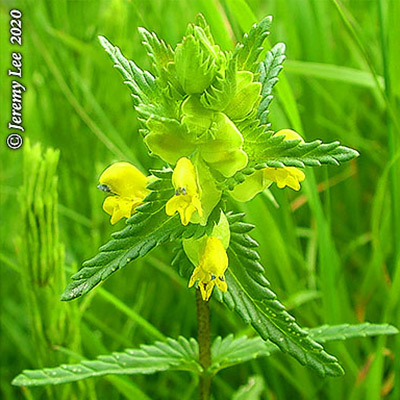
 |
|
Scientific Classifications explained » Amphibians » Ants » Aphids » Bees » Beetles » Birds » Bugs » Butterflies » Caterpillars » Damselflies » Dragonflies » Earwigs » Flies » Frog/Leafhoppers » Fungi » Galls » Grasshoppers » Harvestmen » Hoverflies » Lacewings » Ladybirds » Leaf Mines » Lichens » Mammals » Millipedes » Mosses » Moths » Sawflies » Slugs » Snails » Spiders » Trees & Shrubs » Wasps » Wild Flowers » Woodlice » PB |
UK Nature > Wild Flowers > Yellow Wild Flowers > Rhinanthus minor

Scientific Name: Rhinanthus minor Common Name: Yellow Rattle Rhinanthus minor, more commonly known as Yellow Rattle, Little Yellow Rattle or Cockscomb, is a flowering plant in the genus Rhinanthus in the family Orobanchaceae, native to Europe, northern North America, and Western Asia. Yellow rattle is a grassland annual with yellow, two lipped flowers, the upper lip with two white or purple teeth. Behind the flower the joined sepals inflate to form a green bladder sometimes tinged with red. Flowering occurs from May through to September followed by a seed capsule which rattles within the now brown and papery bladder. The majority of seed ripens in mid to late July and the rattling of the fruit within the bladder was said to indicate that the meadow was ready to be cut for hay, hence its other common name of hay rattle. Research at the UK's Centre for Ecology and Hydrology has shown that encouraging Yellow Rattle to grow in hay meadows greatly increases biodiversity by restricting grass growth and thereby allowing other species to thrive. The seeds are spread very effectively by traditional hay-making practices. |
|

https://www.uknature.co.uk is a website dedicated to showing the immense diversity of UK nature and wildlife. Our vast range of habitats, from lowland arable to snow covered mountains, from storm-ravaged coastlines to peaceful inland freshwater lakes and rivers, from dry, sandy heaths to deciduous and coniferous forests, all these habitats contribute to the abundance of UK nature. We have wild birds in huge numbers either residing or visiting our shores (597 recorded species as at July 2013) and we must also not forget the humble back garden with its grass lawns, flower beds filled with nectar rich flowers, shrubs and trees, all designed to attract huge numbers of insects such as bees, moths, butterflies and hoverflies; and finally the small ponds which provide safe havens for frogs, toads, newts and even slow worms and grass snakes. www.uknature.co.uk is the showcase for my personal passion, photographing uknature in all its glory. I sincerely hope you all enjoy the fruits of my labours. This site and all images contained therein is © Jeremy Lee 2004 - 2025. All Rights Reserved. Site design by Jeremy Lee. Site development & IT Support by Stuart Lee. |